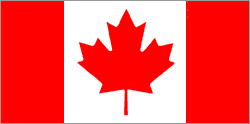Canada’s telecom regulator Industry Canada is set later today to announce the winners of that country’s 700 MHz spectrum auction. The auction is assumed to have wrapped up sometime in the past five days as Industry Canada said before the auction began that it would not release the names of winners or the total amount raised until five days after the auction ended.
The auction began on Jan. 14 after having been postponed from its original start date of Sept. 17. The Canadian government plans to announce license winners at 5 pm Eastern Standard Time today.
Check back with RCR Wireless News later today for results.
The auction involved 10 qualified bidders, with five initially qualified bidders dropping out the proceedings before they began. Those qualified bidders included Rogers Communications, Bell Mobility and Telus Communications, as well as a handful of smaller, regional players including Saskatchewan Telecommunications, MTS and Videotron. Other qualified bidders include Bragg Communications, Feenix Wireless, Novus Wireless and TBayTel.
Bidders that dropped out of the proceedings included private equity group Catalyst Capital Group, BH Wave Acquisition Group, Vecima, 1770129 Alberta and Globalive.
Industry Canada had initially hoped the 700 MHz auction would draw new competitors into that country’s wireless market, which is dominated by its three nationwide operators Rogers Wireless, Telus Mobility and Bell Canada. In setting up the original rules for the 700 MHz auction, Industry Canada said it would apply spectrum caps to the auction in a move to ensure that at least four new entrants enter the wireless space. In addition, build out requirements for rural areas will also be in effect for those companies acquiring two blocks of paired spectrum. Those spectrum caps will place a limit on “prime” spectrum to incumbent operators that is expected to reserve those licenses for new entrants into the space.
In addition, any provider that does not currently own spectrum in the lower bands would be allowed to purchase up to two new spectrum blocks at 700 MHz. The government also said it will apply “specific measures” for its planned 700 MHz spectrum auction “to see that rural Canadians will have access to the same advanced services as everyone else in a timely manner.” The propagation characteristics of the 700 MHz spectrum band are seen as ideal for providing mobile broadband coverage to the vast expanses of Canada outside of city centers.
The new regulations will require companies that control two or more blocks of paired spectrum in the 700 MHz band to cover 90% of the country’s population with their “current high-speed coverage” within five years and 97% within seven years of being granted the licenses. The government also said it would enforce general rollout timelines to both the 700 MHz and 2.5 GHz spectrum licenses ranging between 20% and 50% population coverage within a 10-year period.
Incumbent wireless operators have expressed frustration at the government’s attempt to attract new entrants, noting that such rulemaking limits bidding opportunities for established carriers that are already serving millions of customers.
U.S.-based telecommunications giant Verizon Communications was reportedly looking at potentially entering the Canadian wireless market through an acquisition of one of the country’s struggling operators, but eventually settled on spending $130 billion to buy Vodafone’s stake in Verizon Wireless.
Industry Canada plans to begin the auction of 2.5 GHz spectrum licenses in April 2015 as yet another attempt to encourage competition across the space.
Bored? Why not follow me on Twitter?

